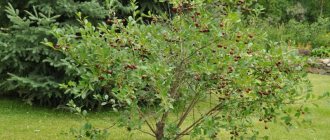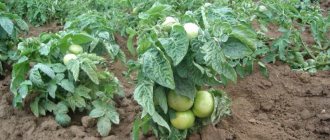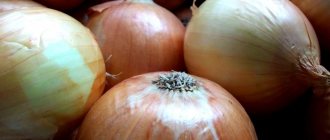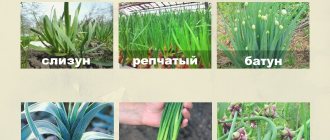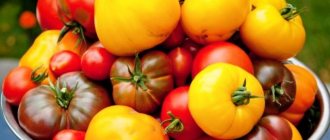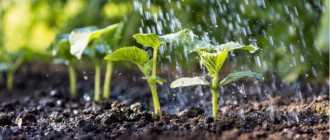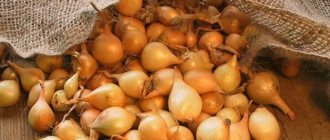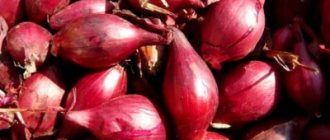The best varieties of onions
Onions, a sought-after, tasty and healthy vegetable, are striking in their diversity - early and late ripening, spicy and sweet, white and red, long-lasting and productive varieties are valued by gardeners; not even the smallest garden plot can do without them. The first step towards obtaining an excellent harvest of the most important crop is to select varieties with the qualities the vegetable grower needs - taste, stability, ripening time, yield and the ability to be stored for a long time with minimal losses.
Early ripening varieties
Stuttgarter Riesen
A common, reliable, early-ripening variety, it takes about 70 days from planting to harvest. The golden-brown onion is small, weighing up to 90 g, flattened, dense. The taste is rich, with pronounced pungency. The yield is constant and high, up to 35 kg per 10 square meters. m.
It ripens up to 55% in the garden and requires ripening, for which the bunches are hung in cool rooms. After this, it shows high safety; over the entire period there are small losses, up to 5%. Weakly resistant to fungal diseases, in unfavorable years it is affected by downy mildew and neck rot.
Yucont
Onion variety Yukont
A reliable variety can be obtained when sown with seeds or sets. When grown from seeds, it ripens within 90 days; when planted as a set, it ripens within 62–73 days after emergence. The shape is flat-round, on average an onion head weighs about 100 g, the taste is piquant and pungent. The upper scales are bright, purple with a crimson tint.
The yield of Yukont depends on the region of cultivation, the maximum indicators are 30 kg per 10 sq. m. It ripens up to 93% in the garden, and after ripening it is stored without noticeable losses for 8 months or more.
Carmen MC
It is preferable to grow productive, beautiful onions from sets; in this case, 65–95 days will pass from planting to lodging of the leaves. Bulb with two or three rudiments, round, leveled, moderately dense, weighing up to 70 g. The pulp is white with a purple tint. The upper scales are few, bright, reddish-violet. The consumer qualities are high, the taste is semi-sharp.
Productivity is average, up to 17 kg per 10 square meters. m. Ripens on the site, does not need ripening, is stored perfectly, with minor losses.
Snowball
Onion variety Snowball
Snowball is recognized as one of the best modern white onion varieties. Its name means snowball, snowball and immediately describes both the shape of its bulbs and color: they are almost round and white, both outside and inside, and the dry scales are even whiter than the juicy ones (and, by the way, its juiciness is very great, and its taste For a semi-sharp dish it’s quite pleasant, you can just eat it fresh). Each such “snowball” weighs about 100 g. In terms of ripening time, Snowball is mid-early, that is, you won’t have to wait too long for its harvest and you can have time to grow it even where the frost-free period is short, especially since this variety is very resistant to bolting. In addition, Snowball's bulbs are quite durable.
The best hot onions
A special feature of the spicy variety is the rapid ripening of the bulbs. Vegetables are stored for a long time, are characterized by a high content of sugars and essential oils, but they are low-yielding.
Stuttgarter Riesen
A fairly productive variety with an average ripening period, characterized by good keeping quality. The bulbs are large, flat-round and dense in structure, weighing 50-90 g, covered with yellowish-brown scales. Vegetables can be planted before winter. Grown through seeding.
Strigunovsky local
The bulbs mature within a maximum of 3 months after planting. To obtain beautiful, juicy and dense, slightly flattened or round specimens of pinkish-yellow color, it is recommended to grow the variety from sets. Ideal for preparation and for fresh consumption. The bulbs develop well regardless of climatic conditions, that is, the harvest can be obtained in areas with arid climates and in areas where there is frequent rainfall.
Galileo
The variety is intended only for growing outdoors. The maturity of the bulb occurs a little more than 4 months after planting. A large specimen can weigh 150 grams. The flesh is greenish-white and has a dense structure; the vegetables have a semi-sharp taste. Can be stored for up to six months.
Kaba
Due to its taste, the Kaba variety is used to add to salads and is considered one of the best. Bulbs ripen 4 months after planting. Large vegetables have a golden yellow color with a brownish tint and weigh 200 grams. It is better to grow the crop within 1 year (from the moment the seeds are sown directly into the ground until harvest).
This variety, not intended for long-term storage, is mostly eaten as it ripens. It is characterized by a loose structure of the bulb, which leads to injury during harvesting.
Mid-season varieties
Aleko
These bright, tasty onions are produced equally well both by sowing seeds and by planting sets; in the latter case, the harvest is obtained in 100–110 days. The onion is round in shape, weighs up to 60 g. The flesh has a sharp, rich taste, dense, white with a purple tint. The upper scales are purple with a purple tint.
Productivity is stable, above average - up to 19.6 kg per 10 square meters. m. Ripens well on the site - up to 94%, requires short ripening, after which it is stored perfectly.
Odintsovets
The round golden bulbs are well preserved, transportable and suitable for mechanized harvesting. Medium size - 60–80 g, white-cream flesh, with a pleasant harmonious taste and slight pungency. The integumentary scales are dense, golden-bronze.
The crop is harvested 110–120 days after emergence, receiving an average of about 15 kg per 10 sq. m. A significant drawback is susceptibility to downy mildew and neck rot, so plants during the growing season need regular treatments with fungicides.
Setton
A universal onion with high taste and excellent preservation, ripens 110 days after planting. On average, it weighs about 120 g, under optimal conditions it can be larger, up to 150–190 g. The shape is round-oval, slightly elongated at the neck. The color of the integumentary scales is yellow, in the area near the neck it is brownish. The pulp is creamy, spicy-sweet, spicy.
The yield is high; with good agricultural technology you can get up to 50 kg per 10 square meters. m. Resistance to fungal diseases and bolting is above average.
Krasnodarsky G 35
An old reliable variety of domestic selection. The harvest is harvested 110–120 days after sowing. The bulb is medium-sized, one-dimensional, weighing about 100 g. The integumentary scales are yellowish-brown with a slight pinkish tint. The pulp is white, semi-sharp taste.
Stable harvest, you can harvest up to 20–40 kg from 10 sq. m. Maturation largely depends on weather conditions and ranges from 50–95%, keeping quality is mediocre. In damp, cool weather it is affected by fungal diseases - downy mildew and neck rot.
Tips for getting quality onions
Below we will present the secrets of growing onions, by adhering to which you can get an excellent and high-quality harvest. These include the following:
- Growing beds should be made where there is sufficient sunlight. Taste qualities directly depend on the lighting of the plant.
- When purchasing seeds, it is recommended to carefully familiarize yourself with the varietal characteristics, since there are onions on sale that are intended only for producing greens.
- The soil required for such onions is loam, characterized by a large number of organic compounds. If grown on land with high acidity, the harvest will be of poor quality and insignificant. In this case, the soil is deoxidized using lime and chalk.
- After planting the seedlings, it is recommended to water the beds no more than once every 7 days. Watering must be stopped as soon as the first fully formed bulbs are noticeable. Onions need frequent moistening only when there is a drought. At moderate temperatures and frequent rain, watering is completely excluded so as not to provoke the spread of infectious diseases. If the crop lacks moisture, then characteristic signs will be present - curved greenery, which gradually begins to turn white.
- Onions are best planted after crops such as cabbage, legumes and tomatoes, carrots, cucumbers, and garlic. Crop rotation is a prerequisite for obtaining a quality harvest. You cannot plant onions in the same place for 5 years, as they severely deplete the soil, will often begin to get sick and the yield will decrease several times.
- It is recommended to plant onions per head in rows, the distance between which will be at least 0.2 m. The splinters are located at a distance of 5-7 cm. If you plant onions often, thinning will be carried out in the future. The torn plant is not thrown away, but is planted in a new bed or used for food.
- Embedding is carried out to a depth of up to 6 cm, the seedlings are covered with earth in a layer of no more than 3 cm.
- Maintenance consists of regularly loosening the soil and removing weeds. Weeds can cause a variety of diseases and nutrient deficiencies in the crop.
Also, to get a high-quality harvest, disease prevention is required. It is recommended to spray with special antifungal drugs, which are purchased at a specialized store. You can prepare a protective agent yourself. This will require 5 liters of liquid, 0.5 tbsp. grated laundry soap and .5 tsp. copper sulfate. Treatment with various solutions is carried out only after the plant has reached 12-16 cm in height. Most often, onions suffer from rust, various rots and black mold.
Late ripening varieties and hybrids
Stardust F1
Attractive snow-white onions attract the eye from afar on market stalls. A medium-sized round head weighs 40–50 g, the flesh is dense and has a pungent taste. Harvesting begins 130 days after planting.
Productivity is good - up to 30 kg per 10 sq. m. The plantings are unpretentious, the plants are resistant to cold and fungal diseases, the hybrid is perfectly stored and transported, and is successfully harvested by mechanization.
Farmer late
Late onion variety Farmer
Excellent for mass plantings, long-term storage and transportation, it works well for sowing seeds in the ground. It takes 130–140 days from germination to harvest. The shape of the bulb is round, the average weight is 250 g, when planted as seedlings it reaches 350 g. The integumentary scales are golden brown, the flesh is white, crispy, with a sharp, rich taste.
The late farmer is valued for the large size of its spectacular onion heads, versatility of consumption, excellent preservation and resistance to fungal infections.
Slava Ozharova
A domestic reliable variety is recommended for the Central Black Earth region, preferably cultivated through early spring sowing of seeds. The shape is round, the color of the upper scales is golden, the taste is pleasant, semi-sharp. The weight of the leveled onions is small, about 70 g.
The harvest matures on the site up to 50–80% and needs ripening. The yield is stable, even, 10–13 kg per 10 sq. m. Advantages - resistance to adverse conditions, shelf life and transportability.
Sweet varieties and hybrids
Spanish 313
The popular variety is famous for its mild sweet taste, which is characterized by a piquant slight pungency. The yellow bulbs are round, large, with white pulp of moderate density, weighing up to 200 g.
Ripens late, 130–140 days after emergence. The harvest is high, reaching 46 kg per 10 sq. m., well stored. Onions are disease-resistant and cold-resistant, which is rare among sweet varieties.
Yalta
Onion variety Yalta
The famous salad onion, suitable for fresh consumption, without bitterness or pungency, is very sweet. The harvest of this variety, traditionally grown by Crimean vegetable growers, can be obtained in the Middle Zone by planting through seedlings in 130–140 days.
The onion is flat-round, weighing about 150 g, deep purple in color with a crimson tint, the inner scales are thick, few in number, white with purple rings. It can only be stored braided and hung in a cool room, not for very long - up to 4-5 months.
Kutnowska
Salad onions, bred in Poland, are recommended for cultivation in the Central region. It is possible to sow seeds in open ground, and the vegetable shows itself to be mid-season - from germination to harvest it takes from 77 to 95 days.
The shape of the small onion is round, weight up to 90 g. The husk is brownish-golden, the flesh is creamy-white, juicy, very tasty, sweet, without pungency. The yield is moderate - 5–9 kg per 10 sq. m. Requires ripening after collection, safety is about 85%.
Caramel
The elongated small onions of this tasty salad variety grow about 10 cm long and weigh up to 60 g. The outer scales are an attractive purple color, the flesh is sweet with a slight pungency and a barely noticeable aroma. Caramel is early ripening and is recommended for growing through seedlings, for which the seeds are sown in March and planted in the ground in May. Harvesting in June-July.
Stored in a cool, ventilated area for several months. For good preservation and winter consumption, they are sown in April-May in open ground, harvesting in August-September.
Densimore
Sweet onions with good preservation and transportability are grown as an annual crop and are mid-season - harvested 115 days after germination. Aligned round onion heads with a thin neck have an attractive appearance and weigh 120–130 g.
The outer scales are golden with a bronze or greenish tint, the flesh is sweet and delicious. It is perfectly stored in ventilated areas, losses are insignificant, the husks do not fall off.
A few secrets of annual onion cultivation
High-quality seed material is one of the most important conditions for obtaining marketable bulbs, but mistakes made during cultivation can reduce the result to zero. There are certain secrets of onion agricultural technology that every gardener needs to become familiar with.
The most important thing is to choose the right seeds. Black onions lose their germination very quickly, and if the expiration date on the package expires in the year of planting, the seeds are considered already old and only 20-30% can sprout. It is best to sow seeds collected the previous fall, then the similarity will be at least 90%. Given the high cost of varietal seeds, this is of great importance in terms of savings.
When and how to collect onion seeds (nigella)
Onion seeds take a long time to germinate, and when grown without seedlings, some of the sprouts become clogged with weeds and die. To prevent this from happening, it is recommended to pre-treat the seeds with a solution of potassium permanganate and soak them in water for a day. A growth stimulator can be added to the water.
Soaking onion seeds
After soaking, the seed is dried until it flows and sown in the ground. As a result of such actions, the seeds hatch faster, and the weeds do not have time to choke out the sprouts.
Sowing onions using a seeder
Onion shoots
For the formation of bulbs, loose, nutritious soil and an open sunny place are needed. The best predecessors of onions are legumes, cucumbers, cabbage and potatoes. The bed should be prepared in the fall: it is dug well, fertilized with rotted compost, and mineral fertilizers are added. On dense soil, the bulbs turn out small, often do not ripen completely and are affected by rot.
To keep onions well, stop watering no later than 3 weeks before harvesting.
The last time the onions are watered is a couple of weeks before harvesting.
The crop is harvested in warm, dry weather, and then dried under a canopy for another week. If these conditions are met, anyone can grow large commercial bulbs from seeds.
Some secrets of harvesting onions
Red varieties
Red Brunswick
One of the best mid-early varieties with a colorful purple color. It is grown by sowing seeds and planting sets; the harvest period is 70–110 days after emergence, depending on the planting method. The shape is rounded-flat, weight is about 100 g. The internal scales are white with a purple rim, the taste is pleasant, slightly spicy.
Consistently productive, yields about 25–30 kg per 10 sq. m. Quite resistant to fungal diseases, preservation is above average, requires short ripening.
Danilovsky 301
Onion variety Danilovsky 301
Delicious onions of domestic selection, classified as mid-season. The waiting time from germination to harvesting is about 100 days. The shape is round or slightly flattened, the weight of the head is 80–150 g. The upper scales are burgundy with a purple tint, the flesh is white with purple rims, crispy and semi-sharp, the taste is closer to sweet.
Productivity depends on cultivation and weather conditions and ranges from 10 to 32 kg per 10 square meters. m. The variety is resistant to downy mildew, transports and stores well, the scales are dense and not prone to shedding.
Campillo F1
A productive hybrid with raspberry-red uniform round bulbs, weighing 110–150 g. Mid-season, when the seeds are sown in April, the harvest is harvested in August-September. The inner scales are thick, dense, whitish-pink.
Requires drying on beds and further ripening in a dry room for 1–2 weeks. It stores well and is resistant to Fusarium wilt and rot.
Black Prince
Large burgundy onions of domestic selection, successfully grown in regions with cold climates, stable and long-lasting. The shape is round, weighing up to 100 g, dry scales are dark purple with a crimson tint. The pulp is juicy, white, semi-sharp taste with a high sugar content. Harvested 100–110 days after emergence, the harvest is significant, reaching 40–50 kg per 10 sq. m. Safety, transportability and commercial quality are excellent.
Red Baron
Onion variety Red Baron
Red Baron is translated into Russian as Red Baron. The onion received this name for the color of its scales - both dry and juicy, they are dark red in color. They are not too large in size, but also rather large - weighing 130-150 g each. True, its taste is not sweet, but semi-sharp, although this makes it no less pleasant, and the shelf life of its beautiful bulbs is for “multi-colored” the bows are very high, it can compete with some sharp ones. This variety is also good because it ripens quite early - in 92-95 days and, as a rule, quickly, so its harvest can be harvested in a short time. It can be grown both as an annual crop (from seeds) and as a biennial crop (from sets).
What is lettuce: description of brief characteristics, photo
Nowadays, lettuce has become very popular. But this name was known only among the people, because lettuce is rather a salad. It belongs to the family not of Onions, but of Angiosperms. This plant is closer in origin to cornflower or wormwood than to onion. We have been familiar with this plant almost since childhood; it is often used as food. The additive is especially popular in dietary nutrition. This variety has become very popular due to its low calorie content. It is only 12 calories per 100 g. It is worth noting that the plant is rich in vitamins such as A, E and folic acid. In addition, the composition includes elements such as potassium and calcium, zinc, and magnesium. The plant serves as an excellent additive to fish and meat. Therefore, it is often used in the preparation of main courses and snacks.
Lettuce onion Lettuce onion
Large varieties
Exhibition
Onion variety Exibishen
The light yellow onion is rounded, elongated, heavy, can weigh half a kilogram, and sometimes 800 g. The taste is excellent, salad, sweet. They are grown by planting seedlings with a planting density of up to 20 pieces per 1 square meter. m. The time from planting seedlings to harvesting is about 130 days.
Exhibition is very productive; due to the large heads, in favorable conditions you can harvest up to 43 kg from 10 sq. m. It ripens poorly on the site, on average 60%, requires long ripening, and storage quality is below average.
Globo
This late-ripening salad variety is characterized by a perfectly round shape and a mild, sweet taste. Ripens within 120–130 days from planting. Very large, weighs 700–800 g, kilogram specimens are not uncommon. The inner scales are white, filled with tasty juice, the husk is yellowish-orange.
Globo amazes with the excellent yield of huge commercial bulbs; it can produce up to 90–120 kg per 10 sq. m. Preservation is average or low, tends to germinate in storage.
Russian size
The huge onion grows to a record weight of 3 kg. The shape is round, slightly elongated at the neck, the integumentary scales are golden-yellow, slightly greenish. The pulp is creamy white, the taste is sweet, delicate with a slight piquant pungency, without a strong odor.
To obtain selected specimens, it is necessary to grow seedlings, sowing seeds in pots in February. In this case, harvesting falls in August-September. The preservation is low; it is often used in salads and preparations.
Yield varieties and hybrids
The most productive are the large-fruited varieties described above, but they are often poorly stored and therefore grown to a limited extent. Below are some excellent yielding varieties and hybrids for mass planting.
Golden Semko F1
Onion variety Golden Semko F1
Early ripening onions are excellent even in the northern regions, grown through sets. When sowing with seeds, 90 days pass from the moment of mass germination to harvesting; when planting with sets or seedlings, the waiting period is reduced and amounts to 70–75 days. The bulb is yellowish-brown, beautiful, round, weighing up to 80 g, the yield is uniform. The taste is sharp, piquant.
Productivity is high - up to 35 g per 10 square meters. m, onions ripen 99% on the ridge and do not require ripening; you can limit yourself to good drying. It is stored perfectly, losses within 7 months are up to 5%.
Universo F1
The mid-season hybrid is suitable for mechanized harvesting, easily transported, and lightweight. It is grown by sowing seeds in the ground, the period from germination to harvest is 110–120 days. The bulbs are golden brown, large, weighing 150–180 g. The inner scales are white, juicy with a pleasant semi-sharp taste and faint odor.
Productivity is consistently high, ranging from 24–43 kg per 10 square meters. m. Ripening on the site is up to 92%, needs to be dried and ripened for a week, after which it lies without loss for up to 7 months or more.
Borodkovsky
A mid-early, long-lived, productive variety works better when planted as sets. The harvest period is 90–105 days from mass germination. The shape of the head is round, slightly flattened, weighing 60–90 g, the husk is golden-bronze. The pulp is white, sharp, with a pleasant aroma.
The yield is consistently high, when grown through seeding up to 36 kg per 10 sq. m., when sowing seeds - about 15 kg per 10 sq. m. It ripens perfectly in the garden - up to 100%; in damp, cold years it may need ripening. Resistant to bacteriosis, weakly affected by rot, but susceptible to downy mildew.
Dnestrovsky
Mid-late harvest onion with semi-sharp taste. Ripens 120–140 days after emergence. The shape is round or rounded-flattened, the husk is yellowish-brown. Weight is about 200 g, individual specimens weigh 300–500 g. The pulp is whitish-cream, tasty, slightly spicy, salad-like.
The yield is high - 35–55 kg per 10 square meters. m. Ripens by 80–90%, requires ripening, after which the safety is 92%.
Ermak
Resistant variety, recommended for cultivation in northern regions. To get an excellent harvest, it is preferable to grow through seeding. Early ripening, waiting period from the moment of planting is 75–95 days. The bulb is spherical, yellow in color, weighing about 200 g, when sown with smaller seeds - up to 100 g. The pulp is dense with a semi-sharp piquant taste. Plants are resistant to downy mildew.
The yield when planted with seedlings is up to 40 kg per 10 sq. m, when sowing seeds the yield is half as much. It ripens 80–90% in the garden and requires ripening for 10–14 days. Stored without loss for 8 months or more.
Strigunovsky local
Onion variety Strigunovsky local
Although the name of this variety contains the word “local”, it produces good harvests throughout the Russian Non-Black Earth Region, and a couple of regions to the south and east of it. True, the further away from the places it is accustomed to, the smaller the turnips will grow: from 3.2 to 1.1 kg/m2. Strigunovsky local is a mid-season variety, it ripens in 77-98 days. Its bulbs are quite beautiful: pinkish-yellow, round or slightly flattened, dense and extremely juicy. It also has one more feature - in order for the harvest to be larger, it must be grown only from sets.
Kaba
Kaba in the Non-Black Earth Zone is considered the best of the salad varieties, because the taste of its bulbs is close to the more southern varieties - only they are semi-sharp. Her turnips ripen later than Strigunovsky - 120-140 days after emergence. Kaba's bulbs are shaped a little like cast iron; they are quite large (up to 200 g), golden-yellow with a brownish tint. It is best to grow this variety in an annual crop - from seeds through seedlings.
Varieties of onions
Varieties of onions according to the amount of essential oils and sugar:
- spicy varieties with a sugar content of 11%;
- semi-sweet onions contain 8% sugar;
- sweet varieties contain about 5% sugar.
The sweetest onion varieties contain the least sugar, but they also contain the least essential oils. It is essential oils that give the taste bitterness and pungency. Below is a list of onion types popular among gardeners with names and descriptions.
Onion
It is better to choose an easy-to-care variety of onion with good yield and long-term storage.
The best productive varieties include: Aleko, Zolotisty, Timiryazevsky. Early ripening varieties are: Carmen, Bogatyrskaya sila, Red Semko. Turnips from onion varieties do not lose their density and taste for a long time: Sturon, Orion, Stuttgarter.
Onions love fertile, loose soil with neutral acidity. It develops actively in good light and air temperatures above +15 degrees. The crop is particularly demanding when it comes to watering during the formation of the underground part. Suitable fertilizers include superphosphate, ammonium nitrate, and potassium salt.
Vegetables can be grown from seeds. Seeds - nigella - are planted in the prepared soil. Next year the sets will be ready. Onion seeds can be bought at the store or collected yourself. The black seeds are in boxes on the arrows that the onion head produces after planting.
Before sowing, seeds are sorted, sorted, disinfected and germinated. In the prepared area, furrows are made at a distance of 20 cm. The seeds are deepened by 2–3 cm.
You can plant seedlings. For planting, heads no larger than 2.5 cm in size are selected. The sets are heated, disinfected and soaked in growth stimulants. As soon as the soil warms up to 10 degrees, the seedlings are deepened by 5 cm.
They begin to plant seedlings before winter when the air temperature drops to -3 at night. It is better to choose a sunny place, without stagnant moisture. The best varieties of onions for winter are: Ellan, Bessonovsky, Arzamassky, Chalcedony.
Care consists of regular watering, loosening the soil after watering and rains, weeding, fertilizing and treating against pests and diseases. The first feeding is carried out two weeks after planting. You can prepare a solution from chicken droppings. After another two weeks, a second feeding is carried out. The third application of fertilizer coincides with the period of active formation of the head.
Leek
Leeks are a biennial herbaceous plant. Has a lot in common with onions. It is distinguished by the absence of a round bulb; long, wide leaves and stem are used for food. The length of the leaves can reach one meter.
All types of onions are divided according to ripening time. Early onion varieties begin to ripen after 140 days, mid-ripening ones after 165 days, late-ripening leeks can be harvested after 180 days or more.
Varieties of leeks that can be grown from seeds: Kamus, Bastion, Tango, Mercury, Bluewing, Vesta, Goliath.
The most common method is the seedling method of planting vegetables. Sowing of seeds begins in late February or early March. Adult seedlings are transplanted in mid-May. Leeks develop best in loamy soil. In autumn and spring, when digging up a plot of land, it is recommended to add humus or compost.
Caring for leeks requires careful and attentive care:
- watering should be abundant and regular;
- the soil should be loosened every week;
- hilling is carried out once every two weeks;
- in order to get a rich harvest over the entire growing season, it is advisable to apply at least two additional feedings;
- Be sure to destroy weeds in a timely manner.
The harvested crop is best stored with green leaves. This will allow the white stem not to lose its juiciness and nutritional components.
Shallot
The difference between shallots and the onion variety is the formation at the base of the nest of several oblong-shaped bulbs, small in size and a larger number of thin feathers. The taste of turnip pulp is sweet, without bitterness.
According to the ripening period there are:
- early ripening varieties: Cascade, Izumrud, Semeiniy, Jasper, Belozerets;
- mid-season types: Airat, Blondin, Kubansky, Bistro, Andreika;
- with late boundaries of bulb ripening: Krepysh, Siberian Amber, Ural Violet, Vonsky.
All shallot varieties are characterized by good disease resistance and drought tolerance. Shallots can be planted in spring and autumn. It is better to choose a sunny place for planting, with non-acidic, fertile, loose soil. Can be grown from seeds and bulbs.
See also
Timing for harvesting onions for storage in central Russia and the regionRead
After planting, the plant should be watered frequently and abundantly. It is recommended to apply fertilizer three times per season, the last application should be three weeks before harvest. In order for the vegetable crop to receive a sufficient amount of oxygen and nutritional components, it is necessary to loosen and weed the soil.
It is imperative to carry out preventive treatment against insect pests (onion flies and nematodes, worms appear most often) and diseases (powdery mildew, fusarium, and neck rot occur).
Chives
Before growing shallots, you need to familiarize yourself with the description of the variety. Oblong brown-white or purple-red bulbs are small, up to 20 pieces. They taste more tender, aromatic and sweeter than onion vegetables.
The aerial part consists of a false stem and numerous tubular, bright green leaves. Schnitt begins to bloom in the second year of growth, in May. In August, instead of flowers, a box with seeds is formed. Young leaves are used for food, which are cut 2-3 times per season.
A place for planting should be chosen that is protected from direct sunlight. The soil should be fertile and moist. Maintenance is standard and involves weeding, loosening, and fertilizing.
Popular varieties of chives are: Bohemia, Crocus, Albion, Honey plant, Siberian, Velta. They can be grown both in open ground and in a greenhouse.
fragrant onion
Alliums have long, flat, dark green leaves. The bulb does not form; instead, a long stalk with a diameter of 2 cm is formed. It tastes juicy with a garlicky flavor. The plant is named fragrant for the delicate aroma of its inflorescences.
The plant does not require special growing conditions, but grows well in loose, fertile soils with neutral acidity. Does not make any special demands on light and tolerates cold well. Leaf growth continues until snow falls.
In spring, new leaves appear in place of old leaves. Greens are used for food only in the second year of plant growth. It is cut three times during the season.
The fragrant vegetable can be propagated by seeds or by dividing the bush. Seeds begin to be sown at the end of April or before winter, at the beginning of October. It is better to divide the bushes in the spring. Popular hybrid varieties of fragrant onions: Fragrant, Aprior, Benefit, Zvezdochet, Piquant, Dzhusai, Vostochny.
Multi-tiered onion
What type of vegetable is there? There are the following varieties of multi-tiered onions that are known among vegetable growers: Gribovsky 38, Likova, Odessky Zimniy, Pamyat.
The multi-tiered bow has an unusual appearance. Instead of inflorescences, large aerial bulbs, called bulbs, are formed on the tubular arrow. The plant forms several arrows with bulbs located at different levels. The leaves are juicy and pleasant to the taste, the bulbs have a slightly bitter taste.
The plant is characterized by high resistance to diseases and pests, is unpretentious and easy to grow. Tolerates drought and frost well. Both above-ground bulbs and the underground part can be used as planting material.
The soil on the site should be light, loose, breathable and fertile. To get a good harvest, you need to add fertilizer to the soil. Care consists of moderate watering, loosening the soil, weeding and timely application of fertilizers.
Onion
Salad onion is a perennial herbaceous plant. The bulb is formed small and not juicy, with thin scales. They do not store well in winter. Only tubular leaves and stems are used for food. The plant is characterized by excellent greenery with a pleasant, delicate flavor. Popular varieties are: April, Giant, Russian Winter.
Batun is very useful for the human body; the product contains a high content of vitamins, microelements, and essential oils.
To plant batun, you need to choose damp, but not swampy areas. First, the soil is dug up and organic matter is added. When growing an annual crop, sowing begins in early spring. To grow as a perennial plant, sowing is carried out in summer or autumn. The seeds are deepened by 1–2 cm.
After the emergence of seedlings, thinning is carried out, leaving a distance of 2.5 cm. When thinning again, the distance is increased to 6 cm. Otherwise, care is no different.
Aging Puchu Bow
Puchu onion is a wild plant that grows on gravelly slopes, in the mountains, and can be found in the steppes. Found everywhere in Mongolia, China, and Korea. In Korea, onions are grown for food. The juicy above-ground part is edible only in spring; in summer, the stem and leaves of the plant become coarser and acquire a bitter taste.
There are 4 types of Puchu:
- The European variety produces long, narrow and straight leaves.
- The Altai-Sayan species is distinguished by short straight leaves.
- The Transbaikal species can be recognized by its powerful bush and short, bent leaves.
- The Far Eastern species has long, spiral-shaped leaves.
The ripening period begins at the end of summer. By this time, the taste of the leaves acquires a pungent aftertaste. The bulbs are cut into rings, dried and added during the preparation of first courses.
Strigunovsky
Onion variety Strigunovsky belongs to the northern group of plants. For full development, it needs a daylength of 15–17 hours. The bulb is round, slightly elongated at the base, weighs 50 g, with a pungent flavor. The scales become yellow when ripe.
The turnip ripens early. The yield of the variety is high, it is well stored all winter, until the next harvest, and does not have any special care requirements.
Tenase
Tenaz onion seeds have average turnip ripening times. It takes 100 days to fully ripen. Dense bulbs weigh 90 g, the taste is semi-sharp. Their shape is round, their scales are golden-yellow. The yield is consistently high and the crop is stored for a long time.
See also
Description, cultivation and care of the hybrid onion variety CandyRead
Valentino
Mid-season hybrids include onions of the Valentino variety. The turnip is round in shape, dense, weighing about 110 g. The scales are brown, the flesh is white and juicy with a semi-sharp aftertaste.
Under good conditions, you can harvest a rich harvest, which can be stored for up to 5 months. The variety is resistant to adverse factors, high resistance to diseases, especially pink root rot.
Bessonovsky
It is worth getting acquainted with the description of the Bessonovsky onion variety, which has good characteristics. The bulbs are small in size, weigh 50 g, round in shape, slightly flattened. The pulp tastes sharp and piquant. The scales are golden yellow.
The harvested crop can be stored for up to 9 months, maintaining its taste and presentation. The variety is an early ripening crop; turnips can be harvested in late July. The plant is characterized by average resistance to disease.
Manas
It is recommended to grow Manas onion from seed as a turnip. The hybrid belongs to late-ripening crops. The bulb is round in shape, semi-sharp in taste, weight 90 g. The upper scales are brown. The pulp is white, juicy.
The yield of the variety is high, characterized by drought resistance and rarely suffers from fungal diseases. The harvest is suitable for long-term storage, while maintaining its taste and presentation.
Green banner
The high-yielding Green Banner onion has early fruit ripening. Type of onion: batun. The plant produces erect leaves up to 50 cm long, dark green in color with a waxy coating.
They retain their juiciness for a long time and do not become rough. Green leaves are frozen, dried and used in cooking. The variety is disease-resistant, especially resistant to fusarium and pink root rot.
Golden
The onion hybrid Golden Semko is recommended to be grown on turnips from seeds. The hybrid has an early ripening period, which lasts 73 days. A dense, rounded bulb weighing 90 g is formed. Dry scales are bright yellow. The taste of the white pulp is semi-sharp.
Taste and commercial qualities are preserved for 6 months. Good development is observed even with irregular watering and high air temperatures.
Danilovsky
The description of the Danilovsky onion variety notes high yield and good resistance to disease. Belongs to the onion type of vegetable crop. Turnip ripening begins after 100 days. Dry purple scales. The taste of the light purple pulp is semi-sharp. The shape of the bulb is flat-round, weight 100 g.
Yellow dragonfly
A mid-season onion variety is Yellow Dragonfly with excellent characteristics. The period from germination to mass lodging of tops is 100 days. The bulb is small, round, slightly flattened. Dry scales are straw-yellow in color. The pulp has a sweet taste, the bulb weight is 60 g.
Sterling F1
The onion hybrid Sterling F1 is recommended for growing on turnips as an annual plant from seeds and as a biennial plant from sets. Belongs to a late-ripening, onion crop. Dry outer scales are white. The taste of the pulp is semi-sharp. The weight of the round bulb is 120 g. The yield is high.
Siberia F1
Onion Siberia F1 is recommended to be grown on turnips from seeds. Belongs to an early ripening crop. The white flesh has a semi-sharp taste. The bulb weighs 100 g. Dry scales are yellow-brown. It tolerates frost well, the variety is resistant to diseases and pest attacks.
Elan
Growing Elan onions from seeds does not present any difficulties. The round-flat bulbs ripen early, their weight is 110 g. The husk is yellow, the flesh is white. The taste is soft, sweetish.
The seeds are frost-resistant and germinate even at a temperature of +1 degree. Before winter, they are sown a month before the onset of frost. Bulbs will begin to form in mid-May. Juicy bulbs are collected in a mule; they are not stored for a long time.
Senshui
The description of the winter hybrid onion variety Senshui notes early ripening, frost resistance, high yield and disease resistance.
The plant reaches a height of 50 cm. The leaves are wide and dark green. The head is round, slightly flattened. The outside is golden yellow, the inner scales are white. Bulb weight 170 g.
Hybrid Kaoba
The Kaoba onion hybrid has an average ripening period. It takes 110 days from planting to ripening. Refers to the onion type of vegetable crop. The fruits are round with a smooth surface and yellow-brown in color.
The variety is characterized by high yield, long shelf life, and high resistance to diseases and pests.
Salad
Salad onions are easy to grow, do not require special care and take up little space. The vegetable crop grows quickly and is rarely susceptible to disease. All types of salad vegetables grow well in fertile, compacted soils. The harvest is stored for no more than 4 months. The bulbs contain many useful components.
Varieties of the salad group include: Exhibition, Yalta, Ermak. The pulp of the bulbs is juicy with a pleasant semi-sharp, piquant aftertaste.
Standing varieties
Traditionally, sharp varieties are considered to have the best shelf life, semi-sharp varieties are stored worse, and sweet onions have the least shelf life.
Bessonovsky local
Onion variety Bessonovsky local
Early ripening onion, with excellent preservation and several nests. The color is golden, the shape is round, slightly flattened, sloping down to a thin neck. Small size - up to 45 g. Internal scales are dense, white, crispy, with a pungent, burning taste. It ripens quickly - 55–80 days after planting.
Productivity is stable, ranging from 11–26 kg per 10 square meters. m. Ripens well, requires drying and is stored for 8–9 months.
Timiryazevsky
Mid-season universal sharp onion of round shape. The color of dry scales is yellow or light brown, brownish at the neck. The weight of onion heads is 50–70 g, ripening when grown in sets lasts 78–82 days from the moment of mass germination.
The yield is high, when grown from sets it is up to 38 kg per 10 sq. m. Ripens completely in the garden - up to 98–100%, in wet years it is worse - up to 70%, and requires ripening and drying. Transportability is high, safety by May is 85%. Affected by downy mildew, moderately resistant to neck rot.
El Dorado
Resistant to cold weather conditions and recommended for growing in northern regions as an annual crop. Ripens 90–110 days after emergence. The bulbs are yellow, heterogeneous in shape - round, oval or slightly elongated, weighing up to 100 g. The pulp is creamy-white, with a pungent taste.
Productivity up to 32 kg per 10 sq. m, requires ripening for 10–14 days. It is characterized by average resistance to downy mildew, can be stored for a long time up to 8–9 months, without significant losses.
Arzamas local
A common domestic mid-season variety with a characteristic pungent taste. Harvest 100–110 days after germination. The bulb is brown-yellow, round, can be oblong, oval or even slightly cubic in shape, greenish at the neck, weighing 70–90 g.
Susceptible to downy mildew, plantings are severely damaged by onion fly. The yield when grown in a two-year crop is high - up to 32 kg per 10 square meters. m. Ripening rate is up to 93%; it requires short ripening before storage. Shelf life is good for 7–8 months.
Azelros
Onion variety Azelros
Excellent in cold regions, disease resistant and productive. It is grown by sowing seeds and planting sets. The bulbs are round, leveled, weighing up to 120 g, with deep yellow scales. The taste of the white pulp is semi-sharp and pleasant. It ripens within 90–105 days from the moment of germination and belongs to the mid-early varieties.
Productivity is high - up to 50–60 kg per 10 square meters. m, advantages - resistance to fungal diseases and excellent shelf life.
Bulbs of the following varieties are also well stored:
- Buran,
- Donetsk golden,
- Golden,
- Karatalsky,
- Skvirsky,
- Strigunovsky,
- Chernigovsky.
Dutch varieties
Grateful Red F1
Dutch hybrid of red onion with exceptional commercial qualities, resistance to fusarium and root rot. Mid-season, the period from sowing to harvesting is 120 days. The round bulb is burgundy-red, dense, shiny. The pulp is white, tasty, slightly spicy.
Productivity is high and stable, ranging from 25–35 kg per 10 square meters. m. After harvesting it needs ripening. Stores perfectly, with virtually no waste. A reliable, attractive hybrid for commercial production.
Brunswick
Brunswick onion variety
The cherry-red round bulbs are slightly flattened, weigh up to 120 g, have an excellent semi-sharp piquant taste, the inner scales are white with crimson rings. Ripens 130 days from planting.
The harvest is consistently high, on average about 32 kg per 10 sq. m. Recommended for cultivation through seeding. Resistant to bacteriosis, excellent storage, high transportability.
Sturon
A wonderful variety of Dutch selection, known for its productivity, resistance to fungal diseases and bolting. It tolerates frosts well, planting at the earliest possible date is possible, but it works better when planted with sets. Ripens 108–115 days after emergence. The bulb is round, with a thin neck, golden in color with a brown tint, the average weight is 110 g, but it can be much larger - up to 190 g. The structure of the pulp is dense, the taste is semi-sharp.
Productivity is high - up to 60 kg per 10 square meters. m, keeping quality is excellent, Sturon does not lose its taste and appearance for 7–8 months after harvesting.
With such a variety of different onions, it is easy for the most experienced vegetable grower to get confused. A pre-compiled list of the most necessary and important qualities of a garden crop will simplify and make the choice optimal. Then they select the best varieties and hybrids that best correspond to the desired characteristics, not forgetting to pay attention to resistance to adverse weather conditions and diseases, as well as the safety of the crop.
Learn more about popular varieties of onions from the video.
Preparing the bed
First of all, attention is paid to predecessors, since onions and other crops are not always compatible. This fact cannot be ignored, as this can lead to negative consequences - withering of the plant and obtaining a poor-quality harvest. It is best to plant it after cabbage, cucumbers and nightshades, as they are not affected by common insect diseases. These crops love a large amount of organic matter and mineral fertilizers, so the onions will not be left without nutrients after them.
Also, this crop can be planted after zucchini. In most cases, carrots are not suitable as a predecessor, since they are removed from the garden bed late and this interferes with the quality preparation of the soil. But it is allowed to be planted after onions or in a neighboring area, as they repel pests from each other.
As mentioned earlier, onions love light and do not welcome highly moist soil. In the fall, the site is dug up and fertilizers are applied. Compost, humus, and phosphorus-potassium additives can be used as fertilizers. If manure was introduced, then onions cannot be planted there for two years. In the spring, the bed is leveled with a rake.
